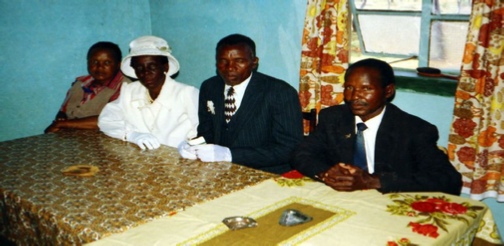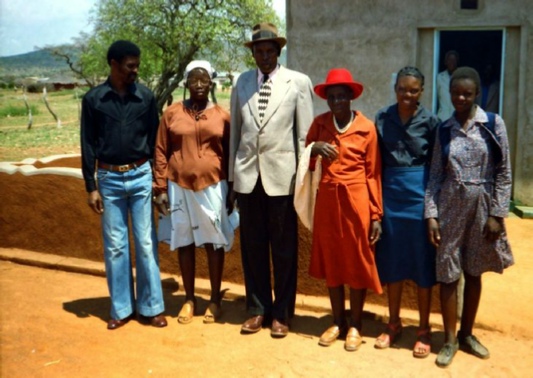© 2018 Dr Margaret Sheppard
Other Weddings
Old People’s Weddings
During fieldwork I witnessed two of these in both cases children of the couple wished to have Sekgoa (English) weddings. But their parents who had been married many years before had been married by a Setswana weddings and had not completed all the traditional customs especially wearing the peritoneum (lomipi) of the slaughtered beast and/or the Maternal Uncle of the bride had never “cooked for the Bogadi (bridewealth). So before the children could be married in the “new” way the traditional customs had to be completed. In both cases the families were Christians and so the parents had Sekgoa (Englsih) weddings where the brides wore white wedding dresses
Nowadays 'wearing the lomipi" is becoming unpopular with modern brides, and "wearing the wedding veil" in a Sekgoa marriage is regarded as a substitute.
A woman originally from the home of one of my neighbours ,did this rather than "wear the lomipi" in October 1980, so that her son would be able to have a Sekgoa wedding. This lady and her husband had originally been married around 1942 with a Setswana wedding, but had failed to "wear the lomipi".Their son was born in 1945 and married, also by a Setswana wedding in about 1970. As he was now a Christian, he wanted to be married in a church and so he would be having a Sekgoa Wedding.
As the parents were also Christians ,they chose "to wear the wedding veil" and so they had a Sekgoa wedding complete with a white wedding dress and "change clothes". They had four grown up children and several grandchildren!


Bride being taken in procession to groom’s house. She is led by her Malome ((maternal Uncle) -


The Chief bridesmaid shelters the bride with a white umbrella
At the groom’s home final preparations being made. Relatives have just brought beer in the white buckets,



On arrival the bride is taken into the house to eat. Her bridesmaid sits next to her. The Best Man next to the groom
Wedding photographs in white wedding dress


Wedding photographs in their “change” outfits

Couple with their children, grandchildren and great grandchild. The marital home and newly decorated lolwapa in the background
The next day at her original kgotla, her Malome (in this case probably his grandson) slaughtered a sheep or goat and a feast was prepared to which her husband’s relatives were invited. Her Malome would have been the original controller of her Bogadi (bridewealth).
As this woman had been "married" for several years then, when the feast had been eaten, her husband and his relatives returned to their home.
Her relatives then brought her, around sunset to the groom’s home. According to tradition they brought her with some meat from the slaughtered beast, a bucket of the traditional beer (specially brewed for the occasion) and some mabele (sorghum) representing seed for the next ploughing season at her husband’s Lands.
After the feast has been eaten and the couple appear in their change clothes the bride’s relatives take her back to her home where she was born.
During one such Bogadi Feast in October 1981. unfortunately the husband became drunk and he then went on to cause great offence at his wife's home by refusing to leave his wife there so that she could be brought later. He not only insisted she should leave with him, but also demanded his meat there and then, which he then took with him in a sack.
This lomipi Feast was as a result considered null and void.

The bride being brought after the Bogadi feast by her maternal kin -



Second Wedding of elderly couple
Bride and Groom sitting in specially prepared area
Bride with her children and grandchildren who were bridesmaids and attendants. Groom had mobility problems so not in photo
Bride and groom in “Change” clothes
After both of these weddings the traditional customs were deemed completed and the children were thus enabled to have their Sekgoa (English weddings).
Groom’s house has been prepared for the bride. N.B. newly decorated lolwapa (yard) walls.
Men “inspecting” the wedding feast


Couple with their children
Couple with their grandchildren



